International Journal of Sports and Exercise Medicine
Severe Musculoskeletal Injuries due to the use of Cleats Whilst Cycling
J Kukadia*, G Zamfir, G Arealis, N Ashwood and B Karagkevrekis
Department of Trauma and Orthopaedics, Burton Hospitals NHS Foundation Trust, UK
*Corresponding author:
Miss Jogisha Kukadia, Department of Trauma and Orthopaedics, Burton Hospitals NHS Foundation Trust, Belvedere Road, Burton upon Trent, UK, Tel: 01283 566333, E-mail: jogisha_kukadia@yahoo.com
Int J Sports Exerc Med, IJSEM-1-019, (Volume 1, Issue 4), Case Series; ISSN: 2469-5718
Received: May 02, 2015 | Accepted: August 31, 2015 | Published: September 04, 2015
Citation: Kukadia J, Zamfir G, Arealis G, Ashwood N, Karagkevrekis B (2015) Severe Musculoskeletal Injuries due to the use of Cleats Whilst Cycling. Int J Sports Exerc Med 1:019. 10.23937/2469-5718/1510019
Copyright: © 2015 Kukadia J, et al. This is an open-access article distributed under the terms of the Creative Commons Attribution License, which permits unrestricted use, distribution, and reproduction in any medium, provided the original author and source are credited.
Abstract
In cycling, pedalling symmetry and foot position is paramount for an energy efficient and injury free ride. Traditionally a clipped pedal was used to secure the foot onto the pedal, which was found to be related to a number of overuse knee injuries, leading to the advent of clipless pedals or cleats, which allowed for a more efficient pedal stroke. Whilst there is some research behind cleat design in football, little remains for cycling. Here we present a series of five patients with severe traumatic musculoskeletal injuries due to the use of cleats whilst cycling, with brief supporting biomechanical rationale. The majority of patients in this series sustained lower limb fractures primarily involving the hip joint, with one patient sustaining upper limb and spinal fractures, highlighting the importance of correct set-up.
Keywords
Cleats, Cycling, Injury, Trauma
Introduction
There are three contact points between a body and a bike during cycling: the handle bars, the saddle and the pedals. This harmony can be disrupted if there is slight anatomical, biomechanical or mechanical mal-alignment. The most integral interaction is the foot to pedal interface with riders averaging up to 5000 pedal revolutions during an hour of cycling. It is this relationship that drives forward motion as the force from the quadriceps and gluteal muscles is transferred to the foot; therefore the design of shoes and pedals is important in achieving this action. Injury usually occurs when the stability of this axis is disrupted [1,2].
A popular way of securing the foot into the pedal is by the use of cleats, which is a device bolted to the sole of a shoe and held in place by a spring loaded mechanism on the pedal. They are a form of clipless pedals that keep the feet securely in place, allowing for a degree of positional variation. Cleats can either be an external attachment or a metal or plastic protrusion at the sole of the shoe. They act to provide traction on an otherwise smooth surface [2].
Once a cleat is assembled and fixed in position it allows for no movement except for a very small number of degrees in abduction and adduction referred to as float, with free float meaning riders do not have to work against spring loaded resistance [2]. In essence this determines the orientation of the whole limb, from the various joint angles and muscle length that contribute to the overall force and economy of movement during pedalling [3,4]. The ease at which one can clip in and out of the pedal is referred to as tension. To disengage the cleat and foot from the pedal, a sideways twisting action is deployed [2].
There are a number of suggested specifications for optimal cleat position. Fore-aft refers to the position that the centre of the cleat is applied to the shoe. With the foot in the shoe, the midpoint between two parallel lines at the level of the base of the first and fifth metatarsal is the fore-aft position, which allows a neutral set-up. Evidence suggests the recommended foot position in the horizontal plane is for the ball of the foot to lie over the pedal axis, thus an anterior foot position, which reduces the risk of stress on the knee ligaments and adds a mechanical advantage to gastrocnemius and soleus [5].
It is very well known that cycling causes a number of overuse knee injuries. However, here we briefly describe five patients who presented with various acute, traumatic injuries all directly resulting from cleat failure. All patients were amateur cyclists who presented following a fall from their bikes where their cleats had failed to release, meaning they were unable to safely dismount in time falling to one side. To our knowledge there is only one case report of a lower limb injury published resulting from cycling and cleat failure [6].
Case series
Case 1
A 54 year old lady, with past history of successfully treated breast carcinoma, presented with a right transcervical neck of femur fracture following her cleat injury. This was successfully managed with cannulated screws with no long term problems on follow-up (Figure 1a and Figure 1b).
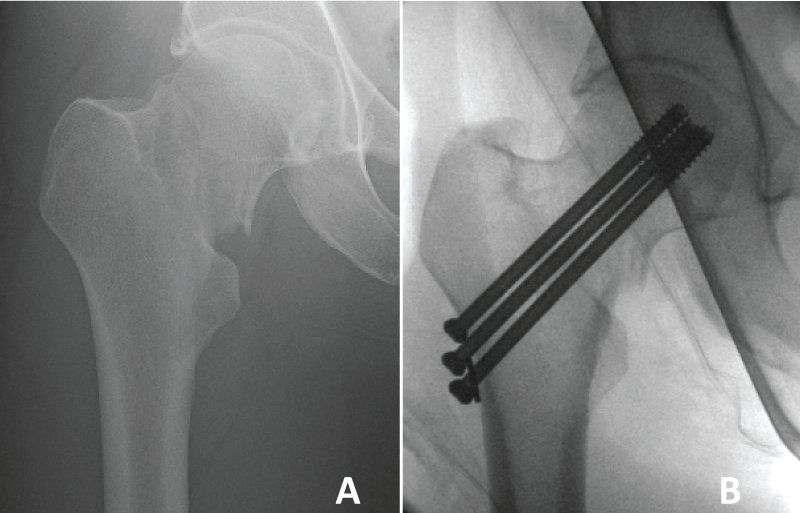
.
Figure 1A: Anteroposterior right hip x-ray showing an oblique fracture through the femoral neck with impaction of the fracture elements and no definite radiographic evidence in support of a pathological fracture.
Figure 1b: Anteroposterior right hip x-ray of the impacted neck of femur fracture fixed with cannulated screws.
View Figure 1
Case 2
A 54 year old male, with no past medical history presented with a left greater trochanter fracture following a fall from his bike. This was managed conservatively, with gradual increase in weight bearing, with no long term issues on follow-up (Figure 2).
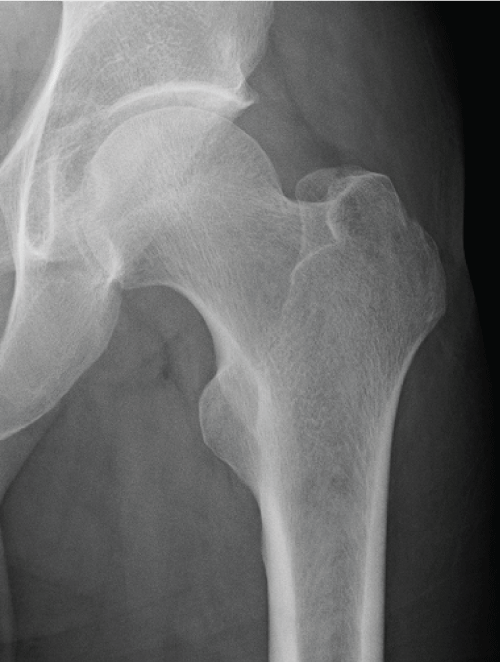
.
Figure 2: Anteroposterior left hip x-ray showing a left greater trochanter fracture.
View Figure 2
Case 3
A 49 year old lady sustained a left trimalleolar ankle fracture-dislocation, who underwent open reduction and internal fixation, whilst on holiday. She also suffered a sprained wrist. Unfortunately the fixation did not hold where she presented to our department two weeks post injury requiring revision of this fixation with syndesmostic screws. On removal of the metal work from the revision the joint was found to be subluxing once again, with the feeling that the syndesmostic soft tissue complex had not healed. This patient subsequently underwent an ankle fusion (Figure 3a, Figure 3b, Figure 3c and Figure 3d).
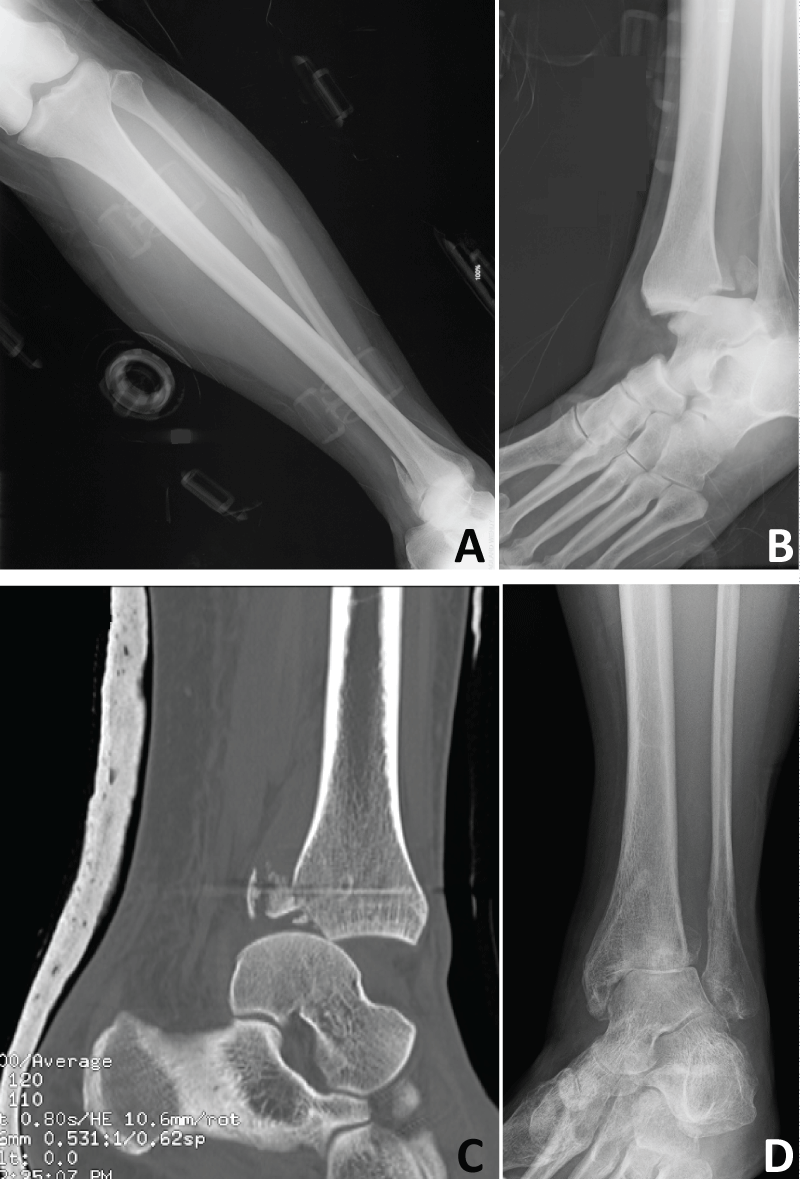
.
Figure 3a and 3b: Anteroposterior and lateral x-ray views of a left Weber C trimalleolar ankle fracture dislocation respectively.
Figure 3c: Lateral view of a CT image showing subluxation post initial fixation.
Figure 3d: Anteroposterior left ankle x-ray view of further subluxation following failed revision surgery.
View Figure 3
Case 4
A usually fit and well 68 year old man sustained multiple injuries after falling onto his left hand side from not being to safely clip out of his cleat. X-ray imaging revealed posterior rib fractures (ribs 5-9), a left clavicle fracture and a displaced base of proximal phalanx fracture of the left ring finger. CT scan further revealed a T3 wedge compression fracture, a left scapular fracture with a small left apical pneumothorax, and a moderate left haemothorax. An intercostal drain was inserted for the management of his haemopneumothorax and his other injuries were managed non-operatively. He received physiotherapy on discharge with no adverse outcomes on follow-up (Figure 4a and Figure 4b).
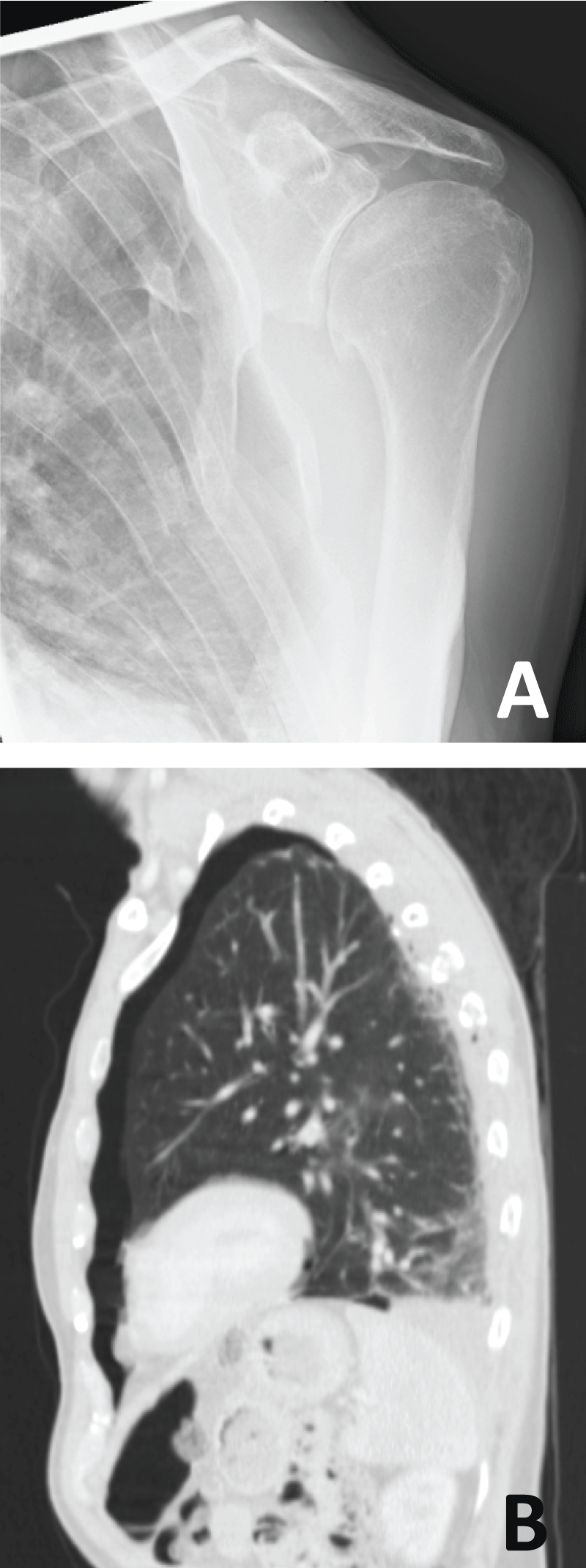
.
Figure 4A: Anteroposterior x-ray showing a left transverse fracture through the middle and lateral thirds of the clavicle, with the fracture apex directed superiorly, with left posterior rib fractures also evident.
Figure 4b: Sagittal slice of a CT scan showing a left haemopneumothrorax.
View Figure 4
Case 5
A 64 year old male presented with a transverse impacted left neck of femur fracture following cleat failure whilst cycling. He underwent a successful total hip replacement with no post-operative complications. He however, was found to have a new diagnosis of vitamin D deficiency (Figure 5a and Figure 5b).
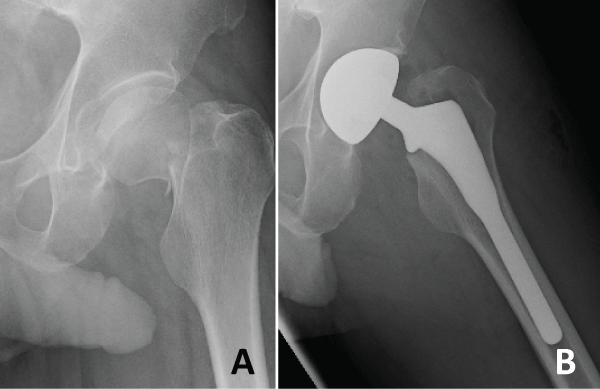
.
Figure 5a: Anteroposterior left hip x-ray showing a left transverse impacted femoral neck fracture.
Figure 5b: Anteroposterior left hip x-ray displaying left total hip replacement in situ.
View Figure 5
![]()
Table 1: Table summarising the case series of patients presenting with injuries resulting from using cleats
View Table 1
Discussion
Up to 9.4% of frequent bicycle users may experience a cycling accident [7], 30% of which are due to a collision with another vehicle [8], resulting in more serious injuries with a higher morbidity and mortality [7,9]. In most cases the cause of the accident is loss of control by the cyclist, when this occurs the ability to use the feet to regain control and avoid falling is important [10]. This is made difficult when the cyclist is attached to the bicycle with cleats. Whilst there is some literature to support cleats as a risk factor for foot and ankle injuries through shoe-surface interaction in football, there is little published evidence in cycling [11-14].
Cleats are important in achieving maximal cycling performance. They must be correctly configured according to their angle and position on the foot and pedal to impact tension, where inadequate traction and stability can lead to injury [15]. If a cleat fails to release on falling, the rider loses all control of the fall, where the entire body may rotate around the clipped foot putting huge torsional forces through the lower limb, altering limb orientation and the ability to safely control clipping in and out of the pedal. All patients in our series described an inability of the cleat to release when falling.
Clipped pedal models and those with rigid float have been found to place stresses on the knee resulting in an increased incidence in knee injuries by altering the natural pedalling mechanics [16]. Incorrect fore-aft position may affect the mechanical axis of the lower extremity during cycling, where the effective length of the forefoot lever arm is increased with cleats positioned too far forward on the sole of the shoe, causing gastrocnemius and soleus to work harder and tire, possible meaning they are less efficient in deploying the sideways twisting action to release from the cleat [2]. Disruption to the anterior foot position in the horizontal plane disrupts the natural anatomical axis, again affecting these muscles which may have led to difficulty in disengaging from the cleat when cyclists have only seconds to react. Sub-optimal foot inclination through incorrectly angled cleats have also caused such injuries and to our knowledge there are no studies investigating the optimal angle of inclination that would provide the most efficient pedal stroke and safe release [16]. Rotation around the vertical axis may also pose a similar problem and increase the likelihood of injuries if not set at the right level. Cleats offering some toe-inward or toe-outward movement have suggested better force transfer but those not enabling any have led to injuries [4,17]. It could be that a subtle manipulation in this plane would reduce injuries by allowing for more outward swing at the heel to release from the pedal.
Whilst we have briefly addressed the various factors affecting the biomechanical axis that may have affected safe release, another cause of the cleat failing to release is wear and tear. This may result from prolonged use or from direct damage secondary to walking on the cleat attached to the cycling shoe, which is supposed to be worn on the pedal only.
Almost all bicycle injuries in young patients are caused by direct impact [7]. In contrast all lower limb injuries in our series seem to have resulted from rotation of one lower limb around the cleat that was firmly attached to the pedal. The patient with the multiple fractures involving the upper body was unable to disengage from both cleats and thus had no control over his fall resulting in direct trauma rather than the rotational element of one lower limb attached to a cleat seen in the other patients. Reports of intracapsular hip fractures resulting from bicycle injuries are common among patients older than 65 years [18] but in our series the two patients sustaining hip fractures were younger than this age, potentially meaning numbers may rise as the sport grows in popularity risking significant morbidity. In addition, most hip fractures are low impact injuries resulting from falling while getting on or off the bike [19] not from falling with the bike in momentum as in our series, combining rotational and direct trauma. This further supports the importance of incorrect cleat set-up attributed to malrotation of the limb when unable to disengage.
To our knowledge this is the only case series of musculoskeletal trauma resulting from using cleats. All injuries occurred in patients with no underlying bone or joint pathology who then went on to suffer a significant amount of morbidity when unable to disengage from their cleats when loosing balance. Although, we were not able to investigate or deduce the cleat position in our patients, Ramos-Ortega et al. suggest that cleat position is unique to each individual and through our discussion it is quite possible this may have been set incorrectly leading to these injuries [3].
It is possible that injuries resulting from cleat failure may be under reported and as bicycles are becoming a common mode of transportation and likely to increase, it is not unreasonable for an increased understanding behind such injuries. Given it could prove to be a major burden on the medical sector we propose a need for further research with a potential to direct improved cleat design [18].
Conclusion
This article highlights the potentially severe musculoskeletal trauma that can result from failure to dismount safely from cleats. Their correct configuration is particularly relevant to professional athletes who undergo considerable revolutions and loads. However, we argue it is just as important in the untrained cyclist and stress the importance of understanding the correct set-up of cleats in recreational cyclists.
References
-
Burke E, Pruitt A (2003) Body positioning for cycling, High-Tech Cycling, USA: Human Kinetics.
-
British Cycling Federation
-
Ramos-Ortega J, Domínguez G, Castillo JM, Fernández-Seguín L, Munuera PV (2014) Angular position of the cleat according to torsional parameters of the cyclist's lower limb. Clin J Sport Med 24: 251-255.
-
Erikson MO, Nisell R (1984) Varus and valgus loads on the knee joint during ergometer cycling. Scand J Rehabil Med 6: 39-45.
-
Wozniak Timmer CA (1991) Cycling biomechanics: a literature review. J Orthop Sports Phys Ther 14: 106-113.
-
Parker J, Patel N, Devarajan G (2011) Proximal femoral fracture in a man resulting from modern clipless pedals: a case report. J Med Case Reports 5: 219
-
Sakurai R, Kawai H, Fukaya T, Yoshida H, Kim H, et al. (2015) Incidence of bicycle-related accidents and subsequent injury in community-dwelling older adults: understanding potential accidents. Nihon Koshu Eisei Zasshi 62: 251-258.
-
Siman-Tov M, Jaffe DH; Israel Trauma Group, Peleg K (2012) Bicycle injuries: a matter of mechanism and age. Accid Anal Prev 44: 135-139.
-
Rivara FP, Thompson DC, Thompson RS (1997) Epidemiology of bicycle injuries and risk factors for serious injury. Inj Prev 3: 110-114.
-
Liu HT, Rau CS, Liang CC, Wu SC, Hsu SY, et al. (2015) Bicycle-related hospitalizations at a Taiwanese level I Trauma Center. BMC Public Health 15: 722.
-
Hennig EM (2011) The influence of soccer shoe design on player performance and injuries. Res Sports Med 19: 186-201.
-
Galbusera F, Tornese DZ, Anasetti F, Bersini S, Volpi P, et al. (2013) Does soccer cleat design influence the rotational interaction with the playing surface? Sports Biomech 12: 293-301.
-
Bentley JA, Ramanathan AK, Arnold GP, Wang W, Abboud RJ (2011) Harmful cleats of football boots: a biomechanical evaluation. Foot Ankle Surg 17: 140-144.
-
Butler RJ, Russell ME, Queen R (2014) Effect of soccer footwear on landing mechanics. Scand J Med Sci Sports 24: 129-135.
-
O'Connor AM, James IT (2013) Association of lower limb injury with boot cleat design and playing surface in elite soccer. Foot Ankle Clin 18: 369-380.
-
Wheeler JB, Gregory RJ, Broker JP (1995) The effect of clipless float design on shoe/pedal interface kinetics and overuse knee injuries during cycling. Journal of Applied Biomechanics 11: 119-141.
-
Gregor RJ, Wheeler JB (1994) Biomechanical factors associated with shoe/pedal interfaces. Implications for injury. Sports Med 17: 117-131.
-
Scheiman S, Moghaddas HS, Björnstig U, Bylund PO, Saveman BI (2010) Bicycle injury events among older adults in Northern Sweden: a 10-year population based study. Accid Anal Prev 42: 758-763.
-
Weinz E, Schönle C (2001) Bicycle accidents in the aged. Sportverletz Sportschaden 15: 8-11.





